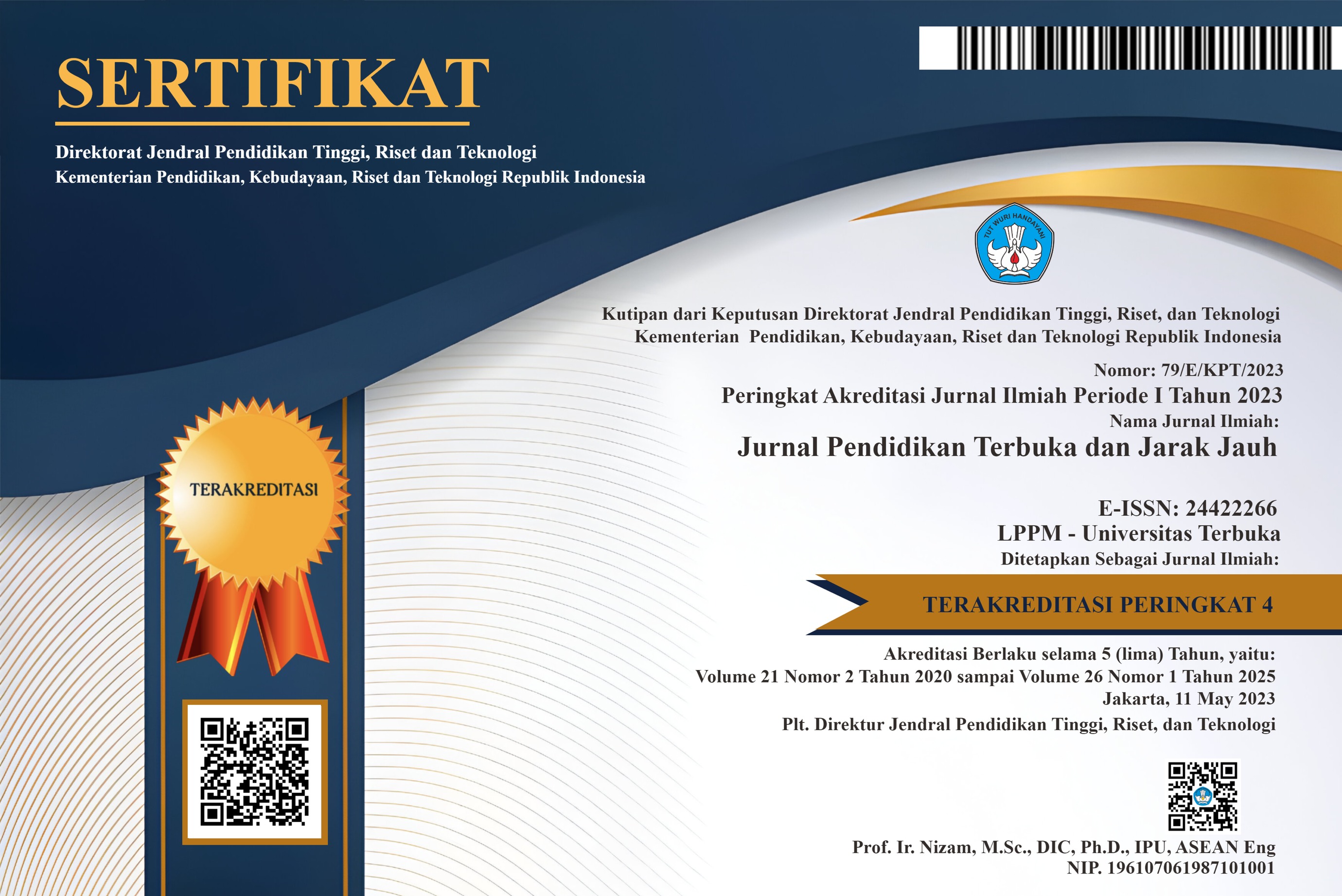Exploring English for Specific Purpose Students' Perceptions of Digital Materials in English Language Learning: Benefits, Challenges, and Recommendations
DOI:
https://doi.org/10.33830/ptjj.v24i2.5501.2023Keywords:
esp, Perception, Digital, EFLAbstract
This study aimed to discover how English for Specific Purposes (ESP) students perceived the utilization of digital resources during their language-learning process. A questionnaire with 20 statements divided into categories like usability, engagement, problems, and recommendations was completed by 28 study participants. According to a Likert scale that ranged from highly agree to strongly disagree, the participants gave their answers. The research found that ESP students generally had favourable opinions of digital resources. They thought the resources were easy to use, available on a variety of platforms and devices, and offered flexibility in their study. The participants acknowledged the motivating qualities of digital resources as well as their role in motivation and the growth of English language proficiency. They did, nonetheless, draw attention to several difficulties, such as the need for more help and technical problems. These opinions of ESP students toward digital materials are revealed, and this knowledge aids teachers and curriculum writers in creating resources for language acquisition that are beneficial. Future studies can concentrate on resolving the issues found and improving the advantages of digital resources in ESP scenarios.
References
Abubakar, M., & Tsuraya, A. S. (2021). Investigating Students’ Eyesights in the Utilization of Platforms in Learning ESP During the Covid-19 Pandemic. Seltics, 4(1), 1–16. https://doi.org/10.46918/seltics.v4i1.954
Agustina, T. (2014). English for Specific Purposes (ESP): An Approach Of English Teaching for Non-English Department Students. Beta, 7(1), 37–63.
Bergdahl, N., Fors, U., Hernwall, P., & Knutsson, O. (2018). The use of learning technologies and student engagement in learning activities. Nordic Journal of Digital Literacy, 13(2), 113–130. https://doi.org/10.18261/ISSN.1891-943X-2018-02-04
Blin, F., & Munro, M. (2008). Why hasn’t technology disrupted academics’ teaching practices? Understanding resistance to change through the lens of activity theory. Computers and Education, 50(2), 475–490. https://doi.org/10.1016/j.compedu.2007.09.017
Erbaggio, P., Gopalakrishnan, S., Hobbs, S., & Liu, H. (2012). A publication of the International Association for Language Learning Technology. 42(2), 27–51. https://www.researchgate.net/publication/331144620_Enhancing_Student_Engagement_through_Online_Authentic_Materials
Erlam, R., Philp, J., & Feick, D. (2021). Digital Media in the Language Classroom. In Teaching Languages to Adolescent Learners (pp. 135–157). Cambridge University Press. https://doi.org/10.1017/9781108869812.008
Haleem, A., Javaid, M., Qadri, M. A., & Suman, R. (2022). Understanding the role of digital technologies in education: A review. Sustainable Operations and Computers, 3, 275–285. https://doi.org/10.1016/J.SUSOC.2022.05.004
Hoesny, M. U., Cahyani, H., & Aziz, I. N. (2020). the Use of Edmodo in Esp Classroom: a Study on Students’ Perception and Classroom Activities. Journal of Languages and Language Teaching, 8(3), 237. https://doi.org/10.33394/jollt.v8i3.2602
Idaryani, & Fidyati. (2021). The influence of digital technology on students’ motivation in learning English specific purpose. Journal of English Language and Education, 6(1), 69–81.
Kaid, M. A. J., Abdulhalim, S. M., Guduru, R., & Yemmela, N. (2019). Attitudes of Saudi EFL Learners towards Speaking Skills. Arab World English Journal, 10(2), 253–364. https://doi.org/10.24093/awej/vol10no2.27
Knihova, L. (n.d.). Digital Media in ESP Instruction for Marketing Communication Digitální média ve výuce angličtiny pro speci ické účely zaměřené na marketingovou komunikaci. 99–114.
Konoplianyk, L. (2018). USE OF AUTHENTIC VIDEO MATERIALS IN TEACHING ESP FOR FUTURE CIVIL ENGINEERS. In Development trends in pedagogical and psychological sciences: the experience of countries of Eastern Europe and prospects of Ukraine. Publishing House “Baltija Publishing.” https://doi.org/10.30525/978-9934-571-27-5_23
Kukulska-Hulme, A., & Shield, L. (2008). An overview of mobile assisted language learning: From content delivery to supported collaboration and interaction. ReCALL, 20(3), 271–289. https://doi.org/10.1017/S0958344008000335
Listari, D., & Rozimela, Y. (2022). The Perception of Students in Using ICT in ESP Course at the Faculty of Mathematics and Science of Universitas Negeri Padang. Proceedings of the 67th TEFLIN International Virtual Conference & the 9th ICOELT 2021 (TEFLIN ICOELT 2021), 624, 25–31. https://doi.org/10.2991/assehr.k.220201.005
Manalu, B. H. (2019). Students Perception of Digital Texts Reading: A Case Study at the English Education Department of Universitas Kristen Indonesi. JET
Nasution, A. K. P. (2022). Social Media Used In Language Learning: Benefits And Challenges. Journal of Linguistics, Literature, and Language Teaching (JLLLT), 1(2), 59–68. https://doi.org/10.37249/jlllt.v1i2.396
Nofianto, N., Puspitasari, D., & Maulida, C. (2020). Teenagers, Digital Media, and Language Development: An Exploration of Potential and Challenges in Promoting English Skills. Journal of English Teaching and Learning Issues, 3(2), 131. https://doi.org/10.21043/jetli.v3i2.8644
Pinto, M. M. A., Isabel Festas, M., & Maria Seixas, A. (2016). Digital media and the challenges for media education. Applied Technologies and Innovations, 12(2), 43–53. https://doi.org/10.15208/ati.2016.04
Ramadhani, R., Aulawi, H., & Ikhwana, A. (2022). University Students’ Perspectives on Lecturer’s Digital Class Organization in Teaching ESP amid Covid-19 Pandemic. Elsya : Journal of English Language Studies, 4(1), 34–44. https://doi.org/10.31849/elsya.v4i1.8643
Safitri, M., Yuliyani, A., Hamid, F., & Suriaman, A. (2022). The Use of Social Media for Learning English: Students’ Perspective. Indonesian EFL Journal, 8(2), 269–276. https://journal.uniku.ac.id/index.php/IEFLJ/article/view/6477/3230
Suganda, P. I. (2022). the Use of Digital Media To Improve Students’ Literacy in English Learning in Junior High School. Jurnal of English Development, 02(02), 99–108. https://doi.org/10.25217/jed.v2i01.2517
Triristina, N., & Khabib, S. (2021). Students’ Perception on the Effectiveness of Teaching Esp for Social and Political Science Program. Social Sciences, Humanities and Education Journal (SHE Journal), 2(2), 83. https://doi.org/10.25273/she.v2i2.9228
Vaičiūnienė, V., & Užpalienė, D. (2012). Authenticity in the Context of Technologically Enriched ESP. Social Technologies, 2(1), 189–201.
Zaim, Z. (2016). The Power of Multimedia To Enhance Learners’ Language Skills in Multilingual Class. Proceedings of the Fourth International Seminar OnEnglish Language and Teaching (ISELT-4), 22–29. http://ejournal.unp.ac.id/index.php/selt/article/viewFile/6905/5439
Downloads
Published
Versions
- 05-01-2024 (2)
- 29-12-2023 (1)
How to Cite
Issue
Section
License
Copyright (c) 2023 Romadhon Romadhon

This work is licensed under a Creative Commons Attribution-ShareAlike 4.0 International License.





